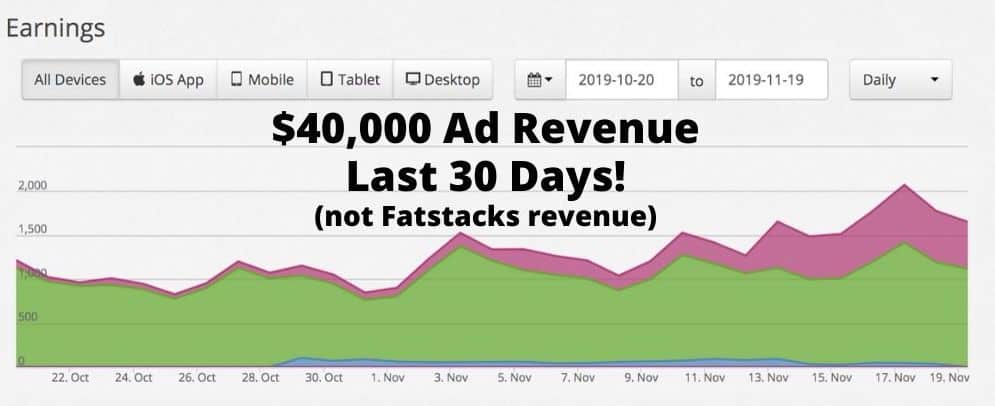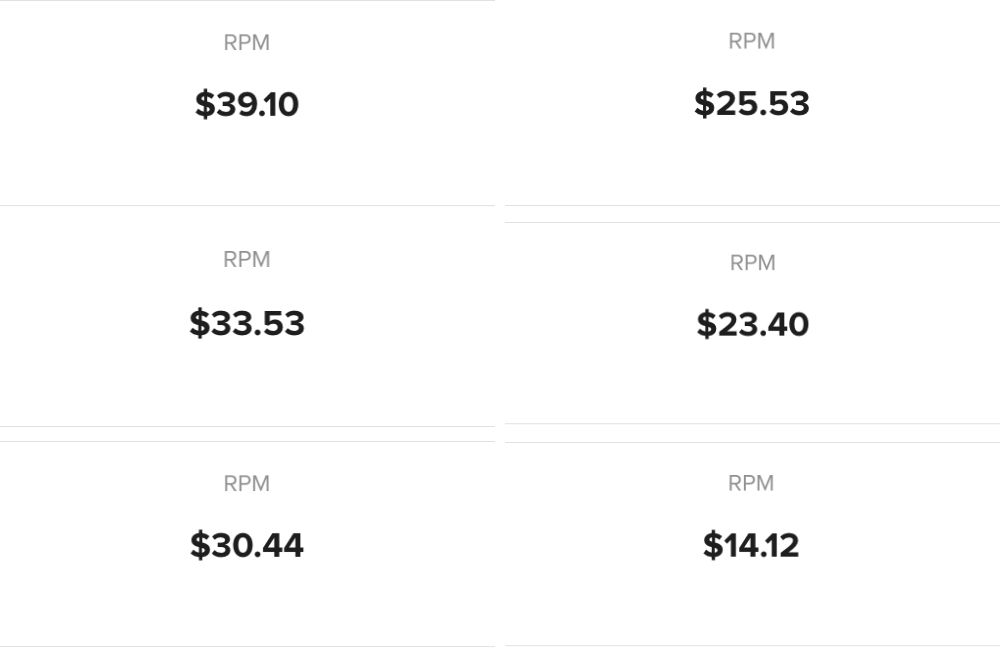Podcast Version
Video Version
The first is the hobbyist. They blog for the joy of writing and their chosen topic. An example is a beer enthusiast who likes to write about beer (gives them an added excuse to drink more of it). Maybe they started blogging after a few too many.
The second is the entrepreneur. They also blog because they enjoy it, but they endeavor to build a business.
I’m the second type. I love running my online publishing business, in part, because it’s a great business to grow.
If you’re here and you want to learn the strategies for how to make gobs of money blogging, keep reading.
But first, what do I know about making money blogging?
While I don’t know everything, I know a thing or two.
I publish several blogs in addition to Fat Stacks (this site). Three of my other blogs earn 4 figures per month. A fourth blog earns $40K+ per month. I’ve been a full time blogger since 2012.
Here are some ad revenue screenshots from one niche blog I publish:


So, I’ve been around the block.
Sadly, I didn’t come up with Zillow or Facebook, but I’m not complaining.
Over the years, I’ve distilled how to make money blogging into 3 main strategies. I set them out below.
The 3 strategies for how to make gobs of money blogging
The following 3 strategies pertain to traffic and monetization strategies for blogging. There’s not much else to making money with blogging other than traffic and monetization. If you master that you’ll have it made. In fact, monetization is fairly easy; it’s traffic that’s the hard part.
1. Rank n’ Bank Strategy
What is it?
Rank n’ Bank is focusing on ranking high-value search terms (keywords) in Google and earning ludicrous amounts of money from those high-value pages.
Usually these pages require a good amount of inbound links from other sites or strategic on-site internal linking where you link to the high-value page from other articles on your site that have plenty of inbound links.
The hard part, if you haven’t guessed by now, is getting the links. Writing the content and promoting products isn’t hard… although do put a big effort into the content. It needs to be great to rank.
Traffic sources?
The main traffic source is Google search, but if you create a high-converting page, you may be able to buy traffic from Google Ads and Facebook (don’t count on this working, but it can).
The downside to this strategy, especially if you only have a few of these pages ranking is if you lose a few slots in Google, your income can plummet quickly. The goal in the long run is to get a good number of thes pages earning well so that you are diversified. Ideally, you’ll have a few of these sites.
How to monetize it?
Usually, the best way to monetize this type of page is with affiliate offers. An affiliate offer promoting a product with links to a merchant. When a visitor clicks a link and purchases, you as publisher earn a commission. Those commissions can add up to substantial amounts of money.
That said, you can have a high-earning page with display ads as well. If you rank for something that pulls in tens or hundreds of thousands of visitors per month, display ad revenue can be very high.
Rank n’ Bank examples
Examples of Rank n’ Bank strategy are as follows:
Amazon product affiliate pages: An example is an article titled “10 Best Basketball Shoes.” The article would set out your opinion as to the best basketball sneaker, top 5 or top 10 basketball sneakers.
Software promotion page: I love promoting software as an affiliate because some software pays recurring commissions and the commission percentage is typically higher than Amazon commissions. In fact, most digital products pay a higher commission.
High-traffic, highly commercial page with display ads: If you rank #1 in Google for something like “Inspirational quotes” which gets over 600,000 monthly searches, that amount of traffic could earn decent ad revenue on autopilot. While that keyword wouldn’t pay much per ad impression or per ad click, the volume would make up for it.
How much money can this make?
There really is no limit. However, let’s look at an example. The keyword “best basketball shoes” is searched 15,000 times per month. Let’s assume you rank #1 for the term which pulls in 12,000 visits per month. Also assume you have a 3.5% conversion rate and that the average commission is $5. That article would earn 12,000 x .035 x $5 = $2,100 per month. While you won’t get rich, that’s just one page.
On the extreme end, suppose you rank #1 for “best diet pills” which gets 12,000 monthly searches. Assume you get 9,000 visitors and have a 4% conversion rate. Diet pills/supplements pay very high commissions which can easily amount to $40 per sale. You would earn 9,000 x .04 x $40 = $14,400 per month.
2. Crank n’ Bank Strategy
What is it?
The crank n’ bank strategy is targeting low competition, easy-to-rank keywords. These keyword typically don’t have much competition and not a whole lot of buyer intent behind them.
The key is publishing a lot of excellent content targeting many such keywords. In the aggregate, a site’s traffic grows to substantial levels.
Traffic sources?
The main traffic source is Google search, but if in a visual niche, Pinterest can be good as well.
The goal here is to publish excellent content that attracts some links naturally, grows your site’s authority and then you can rank for more and more of these keywords.
This takes time to grow to high traffic levels, but once it’s grown, it can be fairly stable. If you lose some rankings, likely you’ll improve other rankings because you have so much content. Moreover, less competitiom will gun for the keywords you go after because they aren’t as lucrative.
How to monetize it?
The usual monetization method is display ads. Some content can include affiliate links, but most of it won’t have much buyer intent behind it so don’t expect affiliate links to earn all that much.
That said, you could go after long tail keywords with buyer intent such as “best basketball sneakers for men with big feet“.
If you want to learn more about monetizing, check out my monster article setting out 47 ways to monetize a blog.
Crank n’ bank example
A good example is an article about the “benefits of aluminum”. Ahrefs reports a keyword difficulty score of 2 out of 100 which is easy to rank. Don’t get too excited though, the monthly search volume is 100 which is also pretty low.
How much can you make?
Again, the sky is the limit with enough good content and time. The analysis for this is different. Instead you look at number of articles and ad revenue.
Suppose you have 500 articles published and the average traffic is 300 visits per month. That would be 150,000 monthly visitors.
Assuming you earn $15 per 1,000 visitors, you would earn $2,250 per month.
On the other extreme, suppose you have 10,000 articles published pulling in on average 400 visits per month and the site earns $25 per 1,000 visitors. This site would earn $100,000 per month from display ads.
3. Mail n’ Bank Strategy
What is it?
Mail n’ Bank strategy is focusing your site on getting visitors to sign up to your email list. Instead of display ads and affiliate links, which sends visitors away, you create incentives for visitors to sign up to your email list.
From there you focus on monetizing via your email newsletters.
Traffic sources?
Traffic sources can include Google search, Facebook, Pinterest and other paid sources. Pretty much any source that converts and provides leads that pay off in the long will work. The paid sources require plenty of testing, but if you pin it down, you can have a constant stream of traffic hitting your site and signing up to your email newsletter.
How to monetize it?
All the monetization happens via the newsletter. The beauty of this strategy is you can contact your leads over and over and over. If you engage them well and they’re interested in what you have to say in the long run, you have a ready batch of buyers with a click of the button.
While you can monetize email newsletters with display ads, you’re better off if you can find affiliate offers that convert. Or, sell your own products such as software and/or digital products like courses.
Niche site example
Fatstacksblog is a mail n’ bank example. While have the odd ad here and affiliate links, the main focus of this site is attracting readers to join my email newsletter.
Email marketing is a massive topic on its own. There are many strategies you can deploy, many of which work. Generally the key is to send out good email newsletters that your audience likes. You want your readers to keep on opening your emails so that you have a large and growing audience any time you like.
Sites that sell software rely on email as well. Often visitors don’t sign up and pay for software on their first visit but may do so after several contacts.
How much can you make?
The revenue potential analsyis here is revenue per subscriber per month. It takes several months to get this data, and you’ll want to work on increasing revenue per subscriber (as well as getting more subscribers).
How much you make depends on how many engaged subscribers you have and how much you earn per subscriber.
One possible scenario is that you earn $.45 per month per subscriber. If you have 50,000 subscribers, you’ll make 50,000 x $.45 = $22,500 per month.
What strategy do I use?
I use all three across my fleet of niche sites. That’s why I know what I’m talking about. However, my largest site deploys the “Crank n’ Bank” strategy monetized with display ads. It has an email newsletter, but it earns very little. The site also has affiliate links, but the revenue is miniscule compared to display ad revenue.
Are the three strategies mutually exclusive?
That’s just a fancy way of asking whether you can use more than one strategy on a blog. Yes, you can use more than one strategy on the same site. Just to make it more confusing, that’s a no, the three strategies are NOT mutually exclusive.
What strategy should you use?
Sadly, that’s for you to figure out. They’re all proven models. My favorite si the Crank n’ Bank strategy, but I can’t deny when properly executed, the other two can be ridiculously profitable and easier in some ways.

Jon Dykstra is a six figure niche site creator with 10+ years of experience. His willingness to openly share his wins and losses in the email newsletter he publishes has made him a go-to source of guidance and motivation for many. His popular “Niche site profits” course has helped thousands follow his footsteps in creating simple niche sites that earn big.







On the Crank’ Bank strategy did you focus on a particular niche ?
Hi Jon, thanks writing up another great article. I have been a follower of your blog recently. I love how you terms those three strategies. I also have a ‘crank and rank’ niche site – the traffic is quite high >150k month but the EMPV is stubbornly low <$5 as the terms I ranked for are mainly reference type. So, people tend to just "get in and get out". I have been thinking of how to add more value to improve the engagement. One idea is building a community forum for those users to help each other out / build up a super-user's profile. Essentially, I want to turn my yellowpage into a yelp. But, I have been postponing this for 2-3 months. Do you have any advice on this?
Finally, I just want to say hi – you are being such a great example for the path I am taking on. And, I enjoy your blog and the stuff you say about writing to be useful. I have 2 niche sites and I have been itching to start a blog and share my experience with working full time and buying / building online assets to for financial freedom. But, it's still too early to say. I have only started doing this from Nov 2019. So, the efficacy is still to be seen. Other than "just do it", do you have any advice on this?
Hey Shane, thanks for stopping by. A community forum can be great if it’s a niche where people actually want to discuss and share.